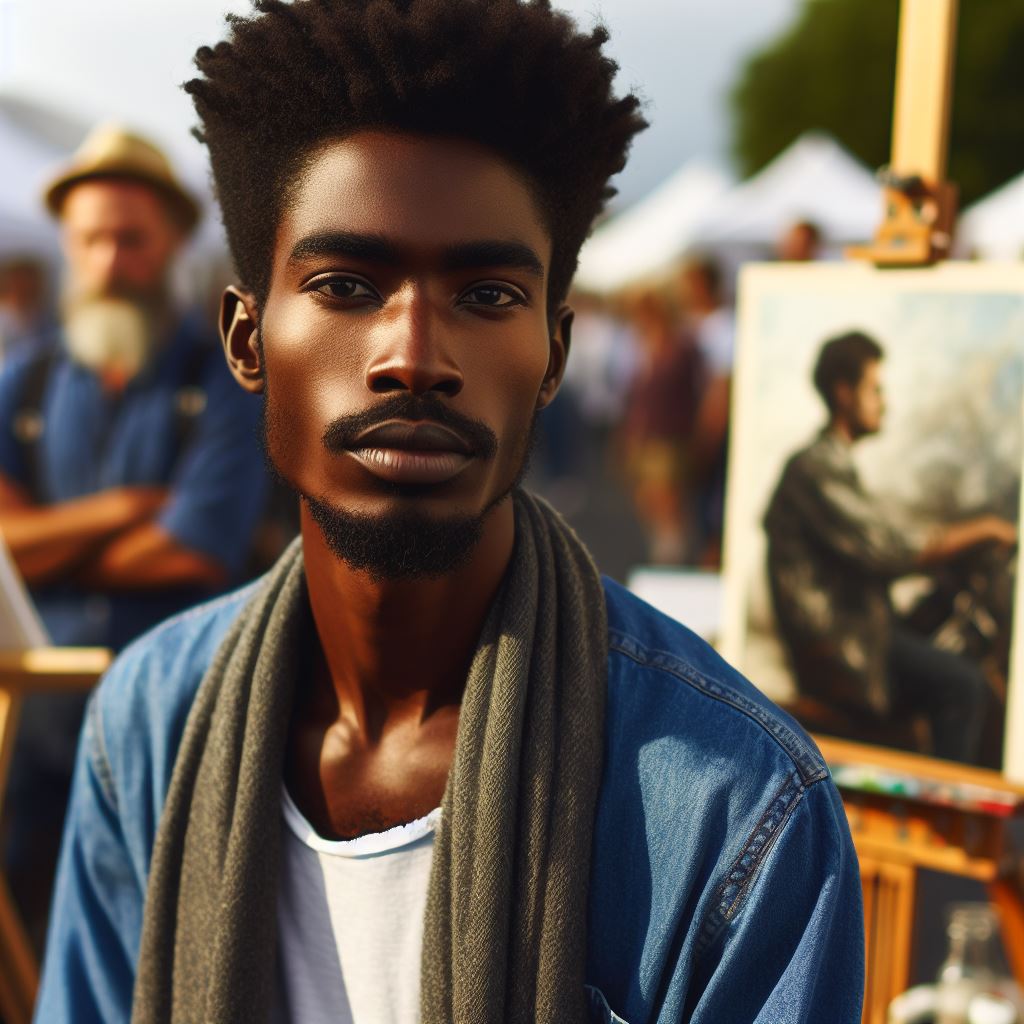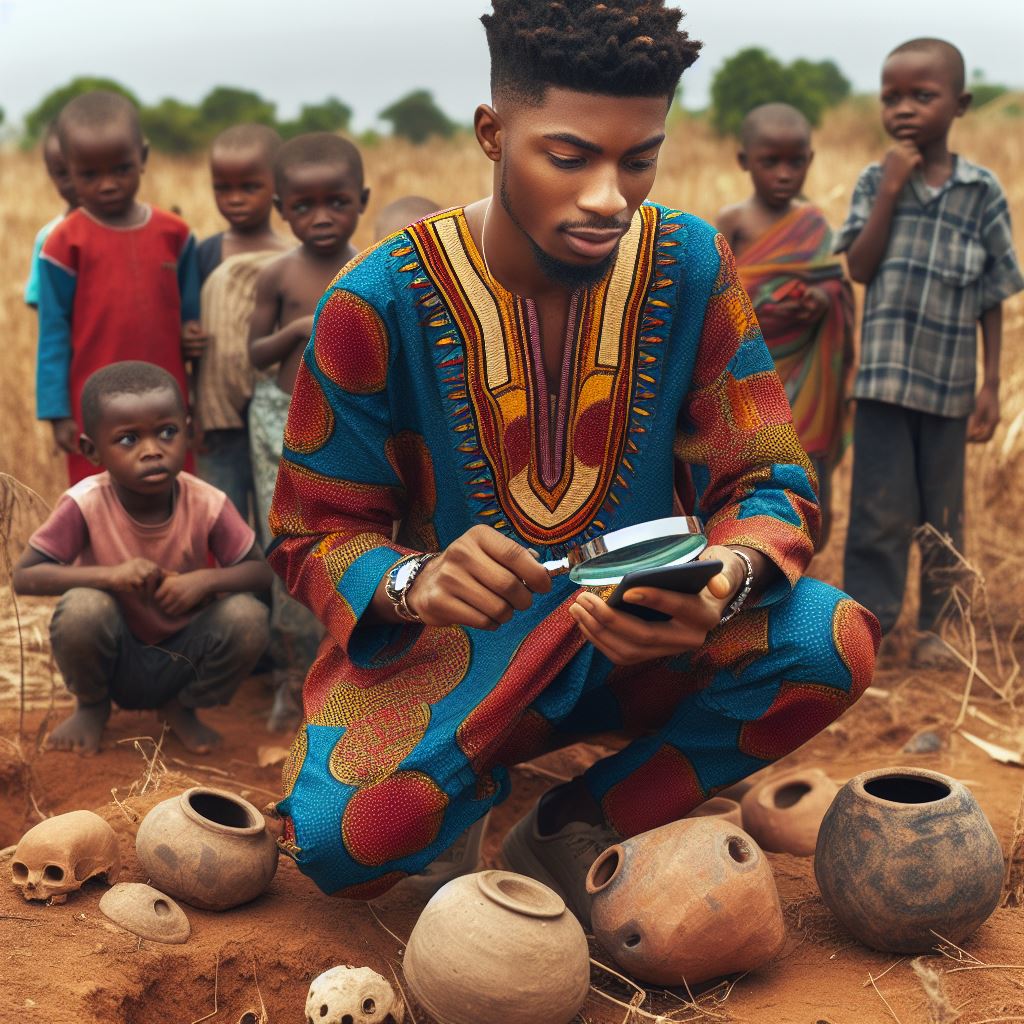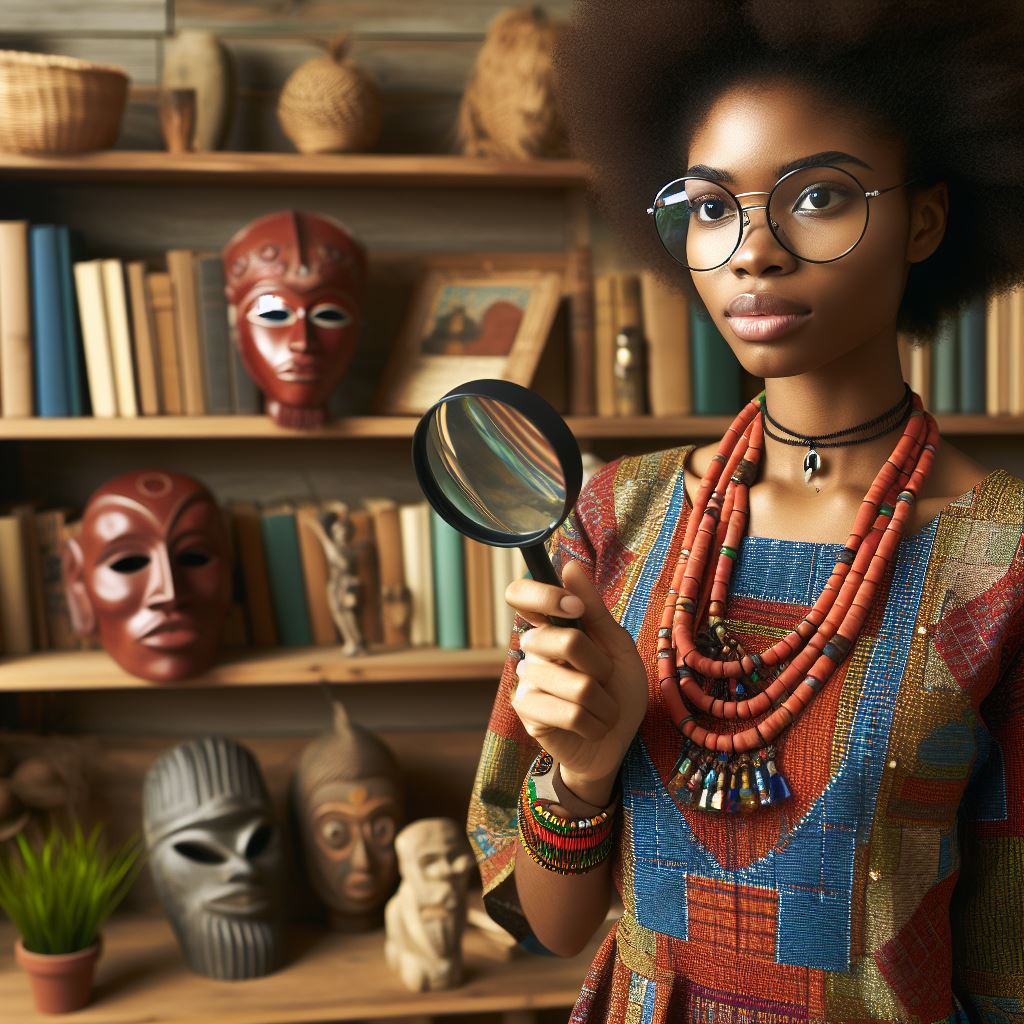Introduction
African art has played a significant role in shaping the artistic landscape of Nigeria.
Nigerian artists have drawn inspiration from various forms of African art to create their own unique styles.
African art is known for its rich cultural heritage and diverse artistic expressions.
Nigerian artists have been influenced by the traditional art forms of their ancestors, such as pottery, textiles, sculpture, and beadwork.
Nigerian artists actively incorporate African art’s motifs, techniques, and materials, reflecting its influence.
They explore related themes in their work, showcasing a rich cultural connection.
Influence of African Art on Nigerian Artists
African art holds a rich and diverse heritage. It encompasses a wide range of visual art forms, from sculpture and painting to textiles and body art. This chapter provides a brief overview of African art and explores its significant influence on Nigerian artists.
African Art: A Brief Overview
African art is vibrant and deeply rooted in tradition. It reflects the cultural and spiritual values of the continent’s many ethnic groups. African art forms include:
- Sculpture: Often made from wood, bronze, and terracotta, sculptures are integral to African art.
- Textiles: These include intricate patterns and vibrant colors used in clothing and ceremonial attire.
- Masks: Used in rituals and ceremonies, masks symbolize various cultural and spiritual beliefs.
- Painting: African painting often features bold colors and abstract forms, reflecting everyday life and spiritual themes.
- Body Art: This includes tattoos, scarification, and body paint, often used in rites of passage and other rituals.
Thesis Statement
African art’s profound influence on Nigerian artists is evident in their work. This influence manifests through traditional techniques, themes, and contemporary adaptations. This chapter explores how Nigerian artists draw from their African heritage to create unique and innovative art.
Traditional Techniques
Nigerian artists often incorporate traditional African techniques into their work. These techniques include:
- Woodcarving: Used to create intricate sculptures and masks, reflecting cultural heritage.
- Weaving: Employed in creating traditional textiles with vibrant patterns.
- Metalwork: Utilized in creating detailed bronze sculptures and jewelry.
- Pottery: Used to produce functional and decorative items, often with intricate designs.
Nigerian artists honor these traditions while infusing them with modern elements.
Cultural Themes
African art’s influence on Nigerian artists is also evident in the themes they explore. Common themes include:
- Spirituality: Many Nigerian artists draw inspiration from African spiritual beliefs and rituals.
- Community: Art often reflects communal life and social structures.
- Nature: Nigerian artists frequently depict nature, animals, and landscapes in their work.
- Identity: Exploration of cultural identity and heritage is a recurring theme.
These themes resonate deeply in Nigerian art, connecting the past with the present.
Contemporary Adaptations
Nigerian artists innovate by blending traditional African art with contemporary styles. This fusion results in:
- Mixed Media: Combining traditional materials with modern techniques.
- Abstract Art: Drawing from African abstraction to create contemporary works.
- Digital Art: Using technology to reinterpret traditional African motifs.
- Performance Art: Integrating African dance and music into visual art performances.
These adaptations showcase the dynamic nature of Nigerian art, rooted in African heritage.
African art significantly influences Nigerian artists. By incorporating traditional techniques, exploring cultural themes, and embracing contemporary adaptations, Nigerian artists create compelling and diverse works.
This influence highlights the enduring legacy of African art in shaping modern Nigerian art. Understanding this influence helps us appreciate the depth and richness of Nigerian art today.
Discover the vibrant world of Nigerian art and see how African heritage continues to inspire creativity.
Historical context
When exploring the influence of African art on Nigerian artists, it is crucial to delve into the rich history of African art and its significance in Nigeria.
African art has a long and revered tradition that has greatly impacted the artistic expression of Nigerian artists.
The history of African art and its significance in Nigeria
Diverse African cultures create intricate art reflecting beliefs, traditions, and societal norms spanning millennia.
In Nigeria, art has always been an integral part of the culture, serving as a means of communication, expression, and spiritual connection.
Nigerian artists draw inspiration from traditional African art, rich in visual language and cultural heritage.
This influence is evident in their masks, sculptures, textiles, and pottery.
These art forms are not just decorative objects but hold symbolic meanings and are used in various rituals, ceremonies, and everyday life in African societies.
Nigerian artists, influenced by African art, deeply resonate with community, storytelling, and spirituality, emphasizing them.
Nigerian artists connect with heritage, express identity, and explore tradition, modernity, and cultural exchange through African art forms.
key periods and movements that shaped Nigerian art
Various periods and movements shaped Nigerian art, contributing to its rich tapestry of artistic expression.
Nigerian art evolves through ancient civilizations, colonialism, and independence, adapting to diverse influences and trends.
The Nok culture, from 500 BC to 200 AD, significantly influenced Nigerian art with its terracotta sculptures portraying intricate details and elaborate hairstyles.
These sculptures have inspired contemporary Nigerian artists to explore themes of identity, heritage, and the human form.
European influences dominated Nigerian art during colonialism, shifting it from traditional practices. Traditional art forms waned due to this influence.
In the post-independence era, Nigerian artists actively reclaimed their cultural identity, blending traditional aesthetics with modern themes.
Nigerian art thrives, drawing from African art, global trends, socio-political issues, and personal experiences.
African art’s legacy shapes Nigerian artists, highlighting their creativity, resilience, and talent in a vibrant landscape.
Read: Art Communities and Networks in Nigeria
Characteristics of African art
Understanding African art involves recognizing its history and cultural influences, shaping it over centuries.
Common themes
African art, renowned for its unique styles, often emphasizes spirituality, community, and nature themes.
These themes are reflected in the motifs and symbols that are commonly found in traditional African art.
- Spirituality: Many African artworks are created to honor and communicate with ancestral spirits or gods.
- Community: African art often emphasizes the importance of community and social connections.
- Nature: The natural world is a common source of inspiration for African artists, with motifs depicting animals, plants, and the environment.
Common techniques
African art employs techniques passed down through generations, embodying a rich cultural heritage.
Transform Your Career with Expert Guidance
Get personalized mentorship consulting that’s tailored to your unique path. Our expert advice is actionable and exclusive.
Get StartedThese techniques often involve intricate patterns, bold colors, and a focus on craftsmanship and skill.
- Carving: Sculptures and masks are often carved from wood, metal, or stone, showcasing the artist’s skill and attention to detail.
- Textiles: African textiles are known for their vibrant colors and patterns, created using techniques such as weaving, dyeing, and embroidery.
- Beadwork: Beads are a common material used in African art, with intricate patterns and designs created through meticulous craftsmanship.
How African Art Influences Nigerian Artists
The characteristics of African art have had a profound influence on Nigerian artists, shaping their artistic styles, themes, and techniques.
Nigerian artists draw inspiration from traditional African art to create modern interpretations that reflect their cultural heritage and identity.
Nigerian artists incorporate traditional African art themes, motifs, and techniques into their work. They honor the continent’s rich artistic traditions.
- Incorporation of Spiritual Themes: Nigerian artists often explore themes of spirituality and mythology in their work, drawing on the ancestral roots of African art.
- Emphasis on Community: Nigerian artists celebrate the importance of community and social connections in their art, reflecting the communal values of traditional African societies.
- Nature-Inspired Imagery: The natural world continues to be a major source of inspiration for Nigerian artists, with motifs and symbols drawn from African flora and fauna.
Nigerian artists carve, weave textiles, and create beadwork, embracing traditional African techniques.
This infuses their art with cultural authenticity and craftsmanship.
In fact, the influence of African art on Nigerian artists is evident in the themes, motifs, and techniques that are present in their work.
Nigerian artists create vibrant, culturally significant art, drawing from the continent’s rich artistic traditions. Their work pays tribute to their heritage.
Read: How to Market Your Art in Nigeria Effectively

Influence on Nigerian artists
Nigerian artists who have been inspired by African art
Fela Kuti
Known for his Afrobeat music, Fela Kuti’s style was influenced by traditional African rhythms and patterns.
His lyrics often addressed social and political issues, reflecting the storytelling found in African art forms.
Kuti’s performances were energetic and expressive, mirroring the dynamic and lively nature of African artistic expression.
Ben Enwonwu
Famous for his sculpture “Africa Dances,” Enwonwu’s work showcases the fluidity and movement found in African art.
He often incorporated traditional Nigerian cultural motifs and symbols into his sculptures and paintings.
Enwonwu’s use of color and texture reflects the vibrant and rich hues seen in African textiles and pottery.
Njideka Akunyili Crosby
Combines painting and collage to create intricate, layered works that draw on her Nigerian heritage and American influences.
Akunyili Crosby’s pieces explore themes of migration, globalization, and identity, influenced by her dual cultural upbringing.
Her use of pattern and texture pays homage to traditional African textiles and beadwork, merging past and present artistic traditions.
El Anatsui
Known for his large-scale sculptures made from recycled materials, Anatsui’s work reflects the resourcefulness and creativity seen in African art.
His pieces often resemble traditional African textiles, with their fluidity, color, and movement capturing the essence of African artistic expression.
Anatsui challenges traditional art by using found objects and unconventional materials. He echoes African art’s focus on innovation and reinvention.
Tomi Adeyemi
Author of the bestselling novel “Children of Blood and Bone,” Adeyemi draws on Nigerian mythology and Yoruba culture in her writing.
Her storytelling is rich in symbolism and imagery, reflecting the narrative traditions found in African art and folklore.
Adeyemi’s work explores themes of power, oppression, and resistance, echoing the social and political commentary often seen in African art forms.
How African art has influenced their style, subject matter, and technique
- Style: Nigerian artists incorporate traditional African motifs, patterns, and symbols into their work.
- Subject matter: African art often inspires Nigerian artists to explore themes of identity, culture, and history in their pieces.
- Technique: Nigerian artists may use methods such as weaving, beadwork, or sculpture, similar to traditional African art techniques.
In short, African art has had a profound impact on Nigerian artists, influencing their style, subject matter, and technique in meaningful ways.
Through their work, these artists not only pay homage to their heritage but also contribute to a global dialogue on art, culture, and identity.
Read: Exploring Art Therapy in Nigeria
Explore Further: Nigerian Artistic Collaborations with the Diaspora
Cultural significance
When we talk about the influence of African art on Nigerian artists, we cannot ignore the cultural significance it holds.
African art has played a crucial role in preserving cultural heritage in Nigeria.
Preserving Cultural Heritage
African art reflects the rich history and traditions of various tribes and ethnic groups across the continent.
Nigerian artists draw inspiration from the ancient artifacts, masks, sculptures, and textiles that define African art.
These art forms link Nigeria’s past, showcasing techniques and cultural practices passed down through generations.
By incorporating elements of African art into their work, Nigerian artists pay homage to their roots and keep these traditions alive.
Means of Cultural Expression
For Nigerian artists, African art serves as a powerful means of cultural expression.
By infusing their work with elements of African art, they are able to communicate themes of identity, history, spirituality, and social issues unique to Nigeria.
Nigerian artists explore and celebrate their cultural heritage through their art. They highlight Nigeria’s diverse traditions.
Their work reveals the practices that make Nigeria a cultural melting pot.
They use African art motifs, symbols, and aesthetics to create visually striking pieces that resonate with audiences both locally and internationally.
In general, African art has had a profound impact on Nigerian artists, shaping the way they perceive and interpret their cultural heritage.
Nigerian artists draw inspiration from African art to create meaningful and thought-provoking works.
They reflect Nigeria’s cultural beauty and complexity, showcasing its diverse landscape.
Read: The Evolution of Nigerian Art Over Decades
You Might Also Like: Nigerian Music: A Cultural Heritage
Contemporary relevance
Contemporary Nigerian artists are deeply influenced by traditional African art forms.
They continue to draw inspiration from the intricate patterns, colors, and symbolism found in African art.
Many Nigerian artists are exploring ways to merge traditional African art with modern techniques and styles.
How African art continues to influence contemporary Nigerian artists
Nigerian artists are studying the rich history and diversity of African art to inform their own work.
They are inspired by the spiritual and cultural significance of African art motifs and symbols.
Contemporary Nigerian artists are using African art elements to create powerful visual narratives.
Ways in which Nigerian artists are adapting traditional African art forms in their work
Nigerian artists are incorporating traditional African textiles and patterns in their paintings and sculptures.
They are experimenting with techniques such as beadwork, weaving, and carving, traditionally found in African art.
Some Nigerian artists are incorporating traditional African masks and sculptures into their contemporary art installations.
In a nutshell, the influence of African art on Nigerian artists is profound and ongoing.
Nigerian artists adapt traditional African art forms, creating innovative expressions that honor Africa’s rich cultural heritage.
Discover More: The Evolution of Nigerian Fashion Design
You Might Also Like: Career Opportunities in Islamic Studies Nigeria
Conclusion
After exploring the influence of African art on Nigerian artists, it is evident that it has played a significant role in shaping their artistic expressions.
Nigerian artists draw inspiration from Africa’s diverse regions, embracing rich cultural heritage and varied art forms.
Nigerian artists incorporate traditional African motifs, symbols, and techniques to create unique, innovative artworks.
These works reflect their cultural identity and heritage.
This cross-cultural exchange has not only enriched the Nigerian art scene but also helped to preserve and promote traditional African art forms.
Nigerian artists, influenced by African art, infuse vibrancy into today’s dynamic art scene in Nigeria.
Artists continue to draw inspiration from African art traditions while also pushing the boundaries of contemporary art forms.
This fusion of tradition and innovation has created a diverse and exciting artistic landscape that celebrates the rich cultural heritage of Africa.
The influence of African art on Nigerian artists is a testament to the enduring legacy of African artistic traditions.
This powerfully reminds us to preserve and celebrate Africa’s rich cultural heritage. Its impact inspires artists worldwide.




